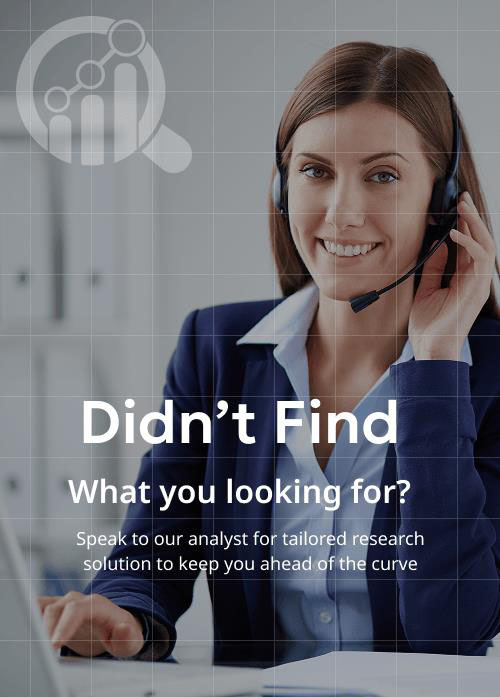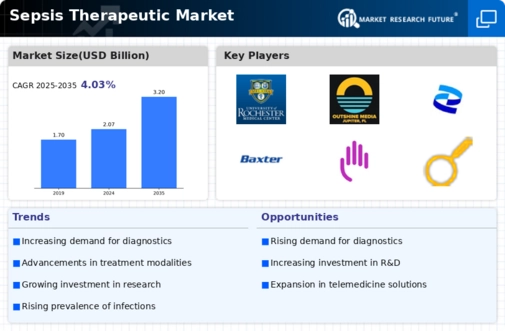Market Growth Projections
The Global Sepsis Therapeutic Market Industry is poised for substantial growth, with projections indicating a market size of 2.07 USD Billion in 2024 and an anticipated increase to 3.2 USD Billion by 2035. This growth trajectory suggests a compound annual growth rate of 4.04% from 2025 to 2035. Various factors contribute to this positive outlook, including the increasing incidence of sepsis, advancements in diagnostic technologies, and rising awareness of the condition. As the healthcare landscape evolves, the demand for effective sepsis therapeutics is likely to expand, reflecting the critical need for improved treatment options in managing this life-threatening condition.
Increasing Incidence of Sepsis
The rising incidence of sepsis globally is a primary driver for the Global Sepsis Therapeutic Market Industry. According to health statistics, sepsis affects millions of individuals each year, leading to significant mortality rates. The World Health Organization reports that sepsis is a leading cause of death in hospitals, which underscores the urgent need for effective therapeutic interventions. This growing prevalence is expected to propel the market, with projections indicating that the market will reach approximately 2.07 USD Billion in 2024. As awareness of sepsis increases, healthcare systems are likely to invest more in therapeutic solutions, further stimulating market growth.
Advancements in Diagnostic Technologies
Technological advancements in diagnostic tools are significantly influencing the Global Sepsis Therapeutic Market Industry. Innovations such as rapid diagnostic tests and biomarkers enable earlier detection of sepsis, which is crucial for effective treatment. These advancements not only enhance patient outcomes but also reduce healthcare costs associated with late-stage interventions. As healthcare providers increasingly adopt these technologies, the demand for sepsis therapeutics is expected to rise. The market's growth trajectory suggests that by 2035, the industry could expand to 3.2 USD Billion, reflecting the critical role of timely diagnosis in managing sepsis effectively.
Emerging Therapeutic Options and Research
The emergence of novel therapeutic options and ongoing research in sepsis treatment are pivotal factors driving the Global Sepsis Therapeutic Market Industry. Pharmaceutical companies and research institutions are focusing on developing innovative therapies, including monoclonal antibodies and immunomodulatory agents, to combat sepsis more effectively. These advancements not only promise improved patient outcomes but also stimulate market growth as new products enter the market. The continuous evolution of therapeutic strategies is expected to contribute to the market's growth, with projections indicating a potential market size of 2.07 USD Billion in 2024, reflecting the dynamic nature of sepsis treatment.
Growing Awareness and Education Initiatives
There is a notable increase in awareness and educational initiatives surrounding sepsis, which is driving the Global Sepsis Therapeutic Market Industry. Organizations and health authorities are actively promoting awareness campaigns to educate healthcare professionals and the public about the signs and symptoms of sepsis. This heightened awareness is likely to lead to earlier recognition and treatment of sepsis, thereby increasing the demand for therapeutic options. As the understanding of sepsis improves, it is anticipated that the market will experience a compound annual growth rate of 4.04% from 2025 to 2035, reflecting the positive impact of education on market dynamics.
Rising Investment in Healthcare Infrastructure
The increasing investment in healthcare infrastructure, particularly in developing regions, is a significant driver for the Global Sepsis Therapeutic Market Industry. Governments and private entities are allocating resources to enhance healthcare facilities, improve access to medical care, and implement advanced treatment protocols. This investment is crucial for addressing the challenges posed by sepsis, as better infrastructure facilitates timely diagnosis and treatment. As healthcare systems evolve, the demand for effective sepsis therapeutics is likely to grow, contributing to the projected market expansion to 3.2 USD Billion by 2035. Enhanced healthcare infrastructure is essential for improving patient outcomes in sepsis management.











